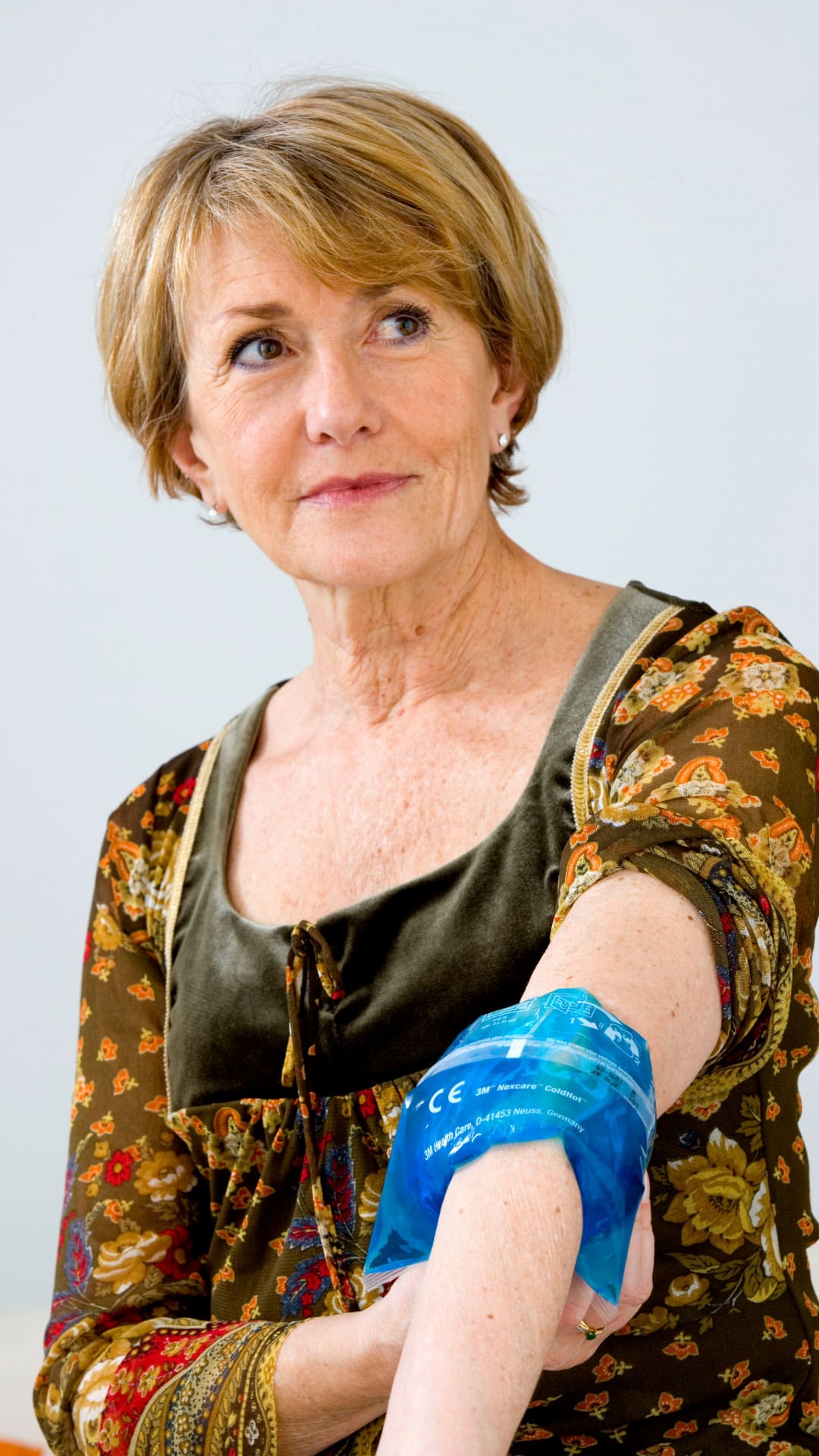A Rare Chronic Illness
Living with a connective tissue disorder like Ehlers-Danlos Syndrome and Hypermobile Spectrum Disorder introduces many unexpected variables into your life. These connective tissue disorders' symptoms include pain, subluxation and dislocation of joints, the propensity to bruise easily, and uncertainty. Proprioception issues are common and lead to frequent injuries.
It is difficult to predict how symptoms will present which makes it challenging to make plans. When plans are made, they need to be flexible so you can maintain your essential EDS daily activities.
The symptoms are are put together a bit differently for each person living with them. Each Ehlers-Danlos Syndrome hypermobility type can cause a variety of symptoms. Everyone with the condition has their own unique combination of aches and pains. They can come and go and change in intensity.
Chronic illness is complicated. The pain is constant, but varies in intensity. Injuries and bruising can happen as a result of regular daily actions like turning a doorknob. It's common to find bruises without knowing what caused them. They can make you look like a victim of abuse.
The world of Ehlers-Danlos Syndrome (EDS) and Hypermobility Spectrum Disorder (HSD) often exists beneath the radar, unseen but deeply felt. It can be a lonely place where nobody truly understands what your going through no matter how much you share your experiences and symptoms. You are dismissed by some and not believed by others.
A condition that has so many symptoms is a challenge to explain. Common sense makes it seem unreal. Nobody can see anything that makes you look sick. It's an invisible chronic illness that makes you secretly suffer.
During Ehlers-Danlos Syndrome and Hypermobility Awareness Month, we try to reach the ears of those who don't even know people with EDS exist. Most people have no idea what it is, and there are even healthcare providers have never heard of it.
It reminds me of the Dr. Seuss story Horton Hears a Whoo. The Whos in Whoville shout out for help and go unheard until Horton the Elephant happens by. He listens and takes action. Horton experiences unique challenges on his journey but perseveres and saves the Whos. We need people like Horton.

The Ehlers-Danlos Syndrome:
Types of EDS
The more the general public knows about this group of rare, chronic diseases, the better the chances become for diagnosis and treatment. There are people out there suffering from generalized joint hypermobility or a type of Ehlers-Danols Syndrome with no information about these forms of Ehlers Danlos Syndrome. Symptoms may worsen if they don't have information about the care they need.
It is difficult to find a doctor who can help you manage your symptoms. If you have no idea of where to start. The EDS diagnosis challenge keeps you from getting timely care. The long process and lack of general knowledge keep you from finding someone who can help, More awareness can you a better chance. It will make the information you need more accessible.
There are 13 types of Ehlers-Danlos Syndrome. Each is classified as a rare disorder and has its own list of signs and symptoms.
They all have genetic markers except hypermobile EDS. This type lists diagnostic criteria with specific measurements that assess physical features and then look for a genetic link to another family member with an hEDS diagnosis. None are simple to deal with, and each type can cause a variety of issues.
All except one of the 13 types of Ehlers-Danlos syndrome have been confirmed with different gene mutations and can be identified by genetic testing.
The other types are all classified as collagen related connective tissue conditions. Each type has it's own features and is caused by a different gene mutation. Since they are genetically different, they don't co-occur. Because of this, each person can only be diagnosed with one type.
Ehlers-Danlos Syndromes are Inherited:
Hypermobile
and
Vascular EDS


Inherited chronic illnesses like connective tissue diseases can go unnoticed for generations. Conditions that are not well known are often not recognized by medical professionals. The general public has little to no exposure to rare diseases.
If parents don't have a rare diagnosis, there isn't an obvious reason to watch children for signs and symptoms. Everybody is in the dark and there's no communication that could lead to medical care.
The EDS diagnosis challenge perpetuates unhealthy habits, beliefs and mindsets. In families without a diagnosis they see their symptoms as normal.
Family member's experience with the condition is normal, so they pass the belief down through generations. They create labels that normalize symptoms further during different life stages.
The children are often told they have growing pains or are avoiding chores. In mid-life the reason for pain and other fatigue is that they are working too hard or taking on too much. Seniors often believe that pain is a normal part of aging. Symptoms are expected and there's a family tradition to work hard and push through pain.
The cause of EDS is a faulty autosomal dominant gene. A parent passes it on. Each child's chance of inheritance is 50-50 when one parent has the condition. Faulty collagen cause issues throughout the body.
Defective collagen weakens connective tissue and causes stretchy, thin skin. Weak connective tissue doesn't support your joints. Overly flexible, loose joints can easily sublux or dislocate. Collagen is a tough, fibrous, protein that holds your body together. It plays a major role in body structure and keeps your organs in place. Organ prolapse is a common problem attributed to faulty collagen production. Another collagen issue is stretchy, fragile blood vessels.
The most dangerous type is vascular Ehlers-Danlos Syndrome (vEDS). It's a connective tissue disorders that can affect the aorta. The vascular type is a rare type that affects blood vessels throughout the body and involves vital organs. The fragile blood vessels caused by thee vascular type can tear with life-threatening results. They can cause arterial dissection and aneurysms. Aneurysms formation are rare, but unpredictable.
The most common type of EDS is Ehlers-Danlos Syndrome hypermobility. Diagnosis starts with a medical history to examine the family history and the patient's symptoms. It then requires a physical examination using the Beighton Score protocol, which includes specific tests and movements. A diagnosis of hEDS requires a score of 5 out of 9 points on the Beighton Scale for adults and at least 6 out of 9 for children.
No test is available to diagnose hypermobile Ehlers-Danlos Syndrome. No blood or genetic testing exists to confirm it. Despite ongoing studies, genetic markers for hEDS have not been identified yet.
The lack of a clear diagnostic test creates a barrier to diagnosis. There are not enough doctors who are comfortable making a formal diagnosis. Most physicians refer to a geneticist or a rheumatologist to deal with diagnosis because it is the only one of 13 types of Ehlers-Danlos syndrome without a genetic marker.
It isn't uncommon for rheumatologists to say they don't treat hypermobility, but are willing to do a rheumatological rule out which is good to have before done before a geneticist appointment. Geneticists are commonly booked out for months and require a referral from a primary care provider. The EDS diagnosis challenge continues to cause stress and lead you on a wild search for providers.
Many people are turned down by at least one geneticist before they are able to make an appointment. Once the appointment is scheduled, there is nothing to do but wait. You can hope for a cancellation, but each geneticist is so in demand there's not a lot of reasons someone would cancel.

Hypermobile Ehlers-danlos Syndrome:
Living with EDS Daily Activities
The hypermobile experience with faulty collagen that makes up our connective tissue goes beyond physical symptoms. Collagen is everywhere and can cause problems anywhere it is located in the body.
Each day may bring more unknowns to add to our cacophony of symptoms. They join the others, sculpt our lives this way and that, and become intertwined with other complex co-occurring conditions. They dictate how you will go about your EDS daily activities.
Coping with so many variables and uncertainties every day adds up and can take a toll on your mental health. Just making all the phone calls required to keep your medical appointments in order is enough to create a high level of overwhelm. It's common that your responsibilities don't match your energy reserves. So many things to do to maintain medical care can leave you emotionally paralyzed and out of energy.
The EDS diagnosis challenge requires us to Navigate the labyrinth of the medical world, from seeking a diagnosis from many different providers to creating some semblance of a sustainable routine while keeping on top of the unpredictable demands of living with hypermobility. It is something only truly understood by those going through it.
Numerous doctor's appointments, diagnostic delays, misdiagnoses, and dismissive treatment take over your life. Each person facing this reality is traversing their version of going "where no one has gone before."
The courage it takes to keep going shines through tired eyes. You live two lives at once. Part of you tries to keep up with real life while the other part juggles your medical existence. Your struggle gets overlooked so often that you might question the reality of your experience. Diagnostic delays can lead to self-doubt. Is this really happening? Do I really feel this? Is it all in my head?
Fortunately, tenacity, love, and community continue redefining what living with hypermobile Ehlers-Danlos Syndrome means. As we all stick together we assure each other that we're not imagining things. We make suggestions, share what has helped even just a little, and support each other through the challenging times.
Together, we are changing what it's like to get diagnosed and live with a rare genetic disorder that has limited treatment options. Seeing a doctor for the first time feels so much better if someone from the hypermobile community has had a good experience there.
The EDS Diagnosis Challenge:
A Problem with Rare Diseases
People with the Ehlers-Danlos Syndromes have a long road to diagnosis that is often demeaning, frustrating, and dismissive. It can take many years of living in a medical soap opera of specialists, tests, and conflicting opinions before finding an expert or a doctor who is comfortable making a diagnosis or willing to learn the criteria.
The lack of information, long wait times between appointments, uncertainty, and unexplained symptoms can go on for an extended period with no end in sight. For many patients, it takes decades.
The aim of hypermobility awareness month is to reduce some of the hurdles patients contend with to get a formal diagnosis.
The lack of familiarity with complex connective tissue disorders among healthcare professionals can create seemingly insurmountable obstacles. Being misdiagnosed repeatedly and having your symptoms dismissed as a mental health issue, looking for attention, or being overweight are symptoms of an awareness gap.
Continually advocating for your health and urging doctors to follow evaluation guidelines for EDS is an uphill battle that takes energy you don't have. Living with hypermobile Ehlers-Danlos Syndrome when you don't know what's going on with your body is a complicated challenge that can leave you feeling desperate.
Doctors are taught in medical school to look for common illnesses. They read about rare diseases but spend little time discussing them. To keep new doctors from regularly considering interesting rare conditions they read about, they learn a saying to keep them on track. "When you hear hoofbeats, think horses, not zebras." This saying is the reason zebras became the symbol of rare diseases.
Keeping thoughts in the realm of the most possible is usually helpful. There's only a problem when the patient has a rare chronic disease.
Diagnosis Complications for
EDS and HSD
Getting diagnosed with a rare disease isn't easy. I've heard countless stories of frustration from clients being dismissed or sent to a psychiatrist for anxiety medications instead of being offered a referral to a rheumatologist, hematologist, or geneticist.
Doctors often attribute hypermobility spectrum symptoms to anxiety rather than exploring the possibility of a rare diagnosis. Doctors learn in medical school to look for the more common diagnoses and give more weight to test results than patient's experiences.
When diagnostics become more about patient persistence and research, treatment becomes less and less accessible. There is a dire need to increase awareness among healthcare providers and reduce the EDS diagnosis challenge. More knowledge can help alleviate unnecessary suffering and expedite accurate diagnoses.

Daily Life with Hypermobility Spectrum Disorder
Being chronically ill is like having a full-time job. Your health becomes your boss. Self-care regimens, daily appointments, endless treatments, therapy sessions, and the other EDS daily activities for self-care can stack up and take over your life.
Managing everything you need to function leaves little time or energy for a to-do list or the personal interactions you used to have with little thought or planning. Now, regular daily chores and pleasurable activities live on the back burner, waiting for their turn to consume a bit of your time and energy.
Living with Ehlers-Danlos Syndrome (EDS) and Hypermobility Spectrum Disorder (HSD) can often feel like being a guinea pig trying one new idea for treatment after another, looking for some relief.
A typical day with Ehlers-Danlos may be carefully planned, but it can all fall apart and become completely unscheduled without notice. Some things must be done no matter how much your body protests.
Medications are difficult to skip. Some appointments are set in stone and impossible to reschedule because you've already been waiting for over eight months. Most everything else can quickly go by the wayside.
The daily schedule for EDS has one constant—pain management. Often a combination of things are required throughout the day to maintain a tolerable pain level. With hypermobile Ehlers-Danlos Syndrome, pain is always present. It goes up and down, but it never goes away.
I feel like I have a strange relationship with pain. I was born with it, so I don't understand the concept of no pain. Instead, I have a common baseline and measure my pain from that point.
A day with more pain than my baseline indicates a day that I'll need to rest more and spend more time and energy taking care of myself. A day with less pain than my baseline means I can most likely do some things, but I have to pay attention and not overdo it. It's a delicate balance.
The necessary things take priority, and I can do something extra if I have any time and energy left. That could be making a phone call, a short chore, or even going to the store. Putting in a load of laundry is a commitment. I never know if I'll have what it takes to put it in the dryer, take it out, fold it, and put it away.
Some people do best with strict structure. I do best with a flexible structure. It helps me be kinder to myself while I navigate the complexities of symptoms and treatments. It allows me to move tasks to another day, change things to make them less demanding, or let some things slide indefinitely. For me, living with hypermobile Ehlers-Danlos Syndrome requires me to prioritize my health and work on letting the unimportant things go.
Chronic pain becomes a part of you. Sometimes, it mixes the boundaries between physical discomfort, emotions, and mental resilience. It just is.
Pain contributes to the unpredictability that's constantly present with a hypermobility spectrum disorder. Pain casts a shadow of uncertainty over the best and brightest moments and can interrupt or cancel well-made plans.
Living in constant pain and battling invisible symptoms within can be exhausting and debilitating. Emotional strength is needed to take on each day's challenges. Each day comes with surprises, which we meet with various reactions, from worry and discomfort to relief and gratefulness.

Living with hypermobile Ehlers-Danlos syndrome:
Support and Understanding
The challenges of Ehlers-Danlos and Hypermobility Spectrum Disorder can be overwhelming.The burden of EDS daily activities can be overwhelming and exhausting. It can be challenging to triage all the things you "should get done."
Some days, online support networks are all that seems to keep you going. They become emotional lifelines when we're down and provide practical information and tried and true experience when needed. Support from people who really "get it" is different. It makes you feel really understood and less alone.
Ehlers-Danlos support is essential. It's rare to find people who truly comprehend the intricacies of living with joint hypermobility syndrome. The solidarity among those who share similar struggles can be incredibly comforting. Support groups and online communities act as digital sanctuaries where we can seek refuge from isolation.
Sharing hypermobile Ehlers-Danlos syndrome experiences, exchanging coping mechanisms, sharing how you manage your symptoms, discussing the EDS diagnosis challenge, and sharing tips on expediting the process bond us together. Simply being there to listen without judgment creates a nice place to visit when you need to feel included.
Peer support communities are safe havens where you are accepted as you are, no one questions your experiences, and information flows freely. Together, we find hope. Each story shared helps others with similar issues.
The same qualities that are important in an online community or a support group are also vital criteria for choosing your best therapist for EDS counseling. Those qualities create a foundation to build a supportive therapeutic relationship.
Caregivers also depend on social media for support. It helps them understand better and get support from other caregivers going through similar experiences. Living with uncertainty while providing unwavering physical help and emotional reassurance is a lot of emotional weight. Watching your loved one struggle is hard.
Despite their own difficulties, caregivers use their emotional and physical energy to serve us when we can't function. Their presence buffers some of the worries that keep running through our heads. Life would be impossible without them.
Self-Care Strategies and Coping Mechanisms for Joint Hypermobility
Navigating life with symptoms of EDS requires a personalized approach to self-care. There are things we know we have to do daily to keep functioning. Each task fits with others to create a plan that works for us.
New ideas are carefully chosen and tried one at a time with as few variables as possible to see if they can support and strengthen the daily protocol. There is a delicate balance between managing physical symptoms, mental well-being, relationships, and overall quality of life.
Learning to pace yourself within the constraints of heritable connective tissue disorders is about making constant adjustments. There is no regular pattern you can rely on. Once you think you've figured out where the line is that tells you it's time to rest, it moves, and you have to start over.
Living with hypermobile Ehlers-Danlos syndrome means you are constantly spending time and energy to manage your symptoms and never quite sure when you might crash and need an extended period of time to recover. Each situation is different. Learning how to read your body's cues takes time. Understanding the ebb and flow of symptoms requires a unique mix of personal attention to detail and self-care to manage your energy and symptoms.
EDS daily activities are not the same from day to day. Recognizing personal limitations helps with making decisions about what each day includes. I weigh an activity ahead of time and decide how important it is to me and how much energy it will require..
Pre-planning helps me prepare for downtime before and after an activity if I decide it's worth it for me to overdo it. Scheduling a day of rest beforehand gives me more energy to play with. The day or two afterward is for recovery.
By paying attention and living within my body's limits, I have a better chance of avoiding a crash. Throughout an activity, I make sure to use self-care strategies so I can keep resting to recharge and prevent burnout. I incorporate restorative things like leaving the room, closing my eyes, helping in the kitchen, or spending some quiet time with someone. These little things help me keep going when my symptoms increase and my energy starts to get depleted.

Hypermobility and Neurodiversity
Hypermobility was only linked to neurodiversity a few years ago. Only a handful of studies have examined the connection.
In their February 2022 study 'Joint Hypermobility Links Neurodivergence to Dysautonomia and Pain' researchers at Brighton and Sussex Medical School found some interesting results:
- More than 50% of neurodiverse participants exhibited elevated levels of hypermobility compared to 20% of general population participants.
- More of the neurodiverse participants reported pain and dizziness upon standing (dysautonomia) than the general population participants.
- The study analysis shows that the neurodivergent population is four times as likely to be hypermobile as the general population.
- Hypermobility is more likely to be found in those assigned female at birth.
The link to neurodiversity highlights the complexity of disorders of connective tissues. More awareness is needed to improve treatment and support and address the EDS diagnosis challenge.
Greater awareness and understanding of how hypermobility is associated with neurodiversity can create a more inclusive environment. Sharing information about hypermobility and neurodiversity will empower those living with these conditions to navigate their unique challenges and get the support they need.
Healthcare providers can offer more comprehensive care to address physical symptoms and potential neurodivergent traits if they know the connection between them. Healthcare providers often overlook neurodiversity because it isn't on their radar. The best therapist for EDS also understands neurodiversity.
A multidisciplinary approach is crucial for the effective care. The connection between hypermobility and neurodiversity can impact cognitive functioning, mental health, and overall well-being. This connection shows the need for awareness in different medical community sectors and specialties.
Ehlers-Danlos Syndrome and Hypermobility Awareness Month exists to advance knowledge, start making steps to improve care, and support research.
People with Ehlers-Danlos Syndrome often experience Mental Health Issues
Living with EDS can take a toll on emotional health as well as physical health. Constant pain, physical limitations, and unpredictability of symptoms can lead to increased stress, anxiety, depression, and suicidal thoughts.
The frustration of not being understood by healthcare providers who may lack knowledge about these conditions can trigger emotional reactions. A common emotional trigger is family members who don't believe symptoms are real. They may see an uncooperative attitude and laziness instead of pain and fatigue.
Chronic illness can get in the way of what you want. Inability to finish school and start a career that is rewarding and creates financial stability can be very depressing and can make you doubt your abilities and worth.
Those with chronic illness need to prioritize mental health support alongside physical treatment. The best therapist for EDS is one who lives with it. They understand from personal experience. There is no need to convince them you are experiencing a long list of seemingly random symptoms. They will accept what you say and make every effort to meet your needs. It's validating to talk to someone who has a similar life experience.
Living with a rare condition is something most people can't get their mind around. The idea of living with pain 24 hours a day, seven days a week is impossible to relate to unless you have experienced it.

Finding the Best Therapist for EDS
Finding a therapist well-versed in hypermobility can make a significant difference in managing mental health challenges that come with chronic illness.
When you don't have to spend a lot of time and energy explaining what you're experiencing, it's easier to get to the current issue. A therapist who knows what you're going through can make you feel comfortable enough to talk about things that others might not believe. They won't try to get you to do things others think you can push through and accomplish. They know the cost.
A hypermobile Ehlers-Danlos Syndrome knowledgeable therapist can help you navigate the complex emotional landscape that comes with chronic pain conditions like connective tissue disorders. The best therapist for EDS is someone familiar with the burden a potpourri of symptoms create. A therapist who understands the unique challenges you contend with every day can help you design tailored treatment strategies to handle the physical and emotional aspects hypermobility you want to address.
A therapist well-versed in chronic illness can help you find strategies for coping with anxiety and depression related to medical uncertainty, provide support navigating family and social relationships impacted by symptoms. They can empower you to advocate for your unique needs within healthcare settings and build strategies that work for you.
An EDS support therapist should at least have experience with chronic illnesses. If they live with a chronic condition, they will understand even better. They will have first-hand knowledge about traversing the healthcare system. They will understand the process of finding things that work by limiting all the variables possible. They know what it's like to deal with integrating all the medical necessities into daily life.
A counselor or therapist knowledgeable about the intricacies of living with EDS understands its impact on daily life and is less apt to cause unintentional harm. When you feel safe in session, your therapy will be more effective.
A psychotherapist with experience supporting clients dealing with hypermobility can find valuable resources to help you manage your symptoms and cope with the psychological impact of living with chronic pain and uncertainty every day. Building a strong therapeutic relationship based on trust and open communication is a key component in ensuring your counseling sessions are effective.
The best therapist for EDS is the one who can develop a trusting therapeutic relationship that allows you to feel safe, be yourself and focus on addressing your needs. Together, you will be able to co-create solutions that feel comfortable and fit your lifestyle.
Finding the
Best Therapist
for EDS
Balancing Life with Chronic Illness and still Manage your Symptoms
Managing Ehlers-Danlos Syndrome and Hypermobility Spectrum Disorder and finding equilibrium amidst the unknowns of a rare condition helps us develop resilience. Sometimes we get stuck in the overwhelm created by numerous unknowns making our lives unpredictable.
Living in uncertainty makes it difficult to find balance. Someone who can see the whole picture can help you possibilities when you are immersed in your issues. An experienced EDS counselor can help you find your way through the emotional distress and physical challenges.
You can manage your symptoms and still get some things done if you make a flexible plan. You don't have to get everything done, and the things you do get done don't need to happen in one shot. A little at a time, resting between steps is an acceptable way to do tasks. Some will be spread over hours and others may need weeks or months.
Therapy sessions provide a safe space to explore your identity beyond the confines of illness. You are not your illness. You are unique. You can develop awareness that improves self-care and self-acceptance. Taking care of yourself is a strength, not a weakness.
Prioritizing mental health helps build resilience and add hope to the future. While the weight of living with EDS and HSD can often feel overwhelming, discovering moments of joy and contentment along the way can nurture your mental well-being. Therapy can help you notice more beauty inside you and around you. It can help you realize your value is not attached to productivity.
I often refer to myself as "a delicate flower." There is a long list of things I need to avoid or be careful about. When I think about it, I'm growing in an inhospitable environment and doing okay.
Despite hardships, beauty and happiness shine through and make my life worthwhile. I try to focus on what I can do and what I can contribute. Personal fulfillment is an integral part of maintaining my mental health.
One of my themes for Ehlers-Danlos Syndrome and Hypermobility Awareness Month is that there is still space for joy and pleasure. Yes, there are many symptoms that can get in the way of "having a life," but there are also fulfilling things that improve life with a perspective built by experiences and what we notice.
Allowing myself flexible goals and remembering to celebrate small victories confirm my personal agency despite my chronic illness. Helping others along the way brings me joy, connection, and satisfaction. It proves to me that I'm doing something worthwhile.

Advocacy for Hypermobility Education
Advocating for Ehlers-Danlos Syndrome (EDS) and Hypermobility Spectrum Disorder (HSD) awareness helps others get a glimpse of what it's like to live with these conditions. It lets them see what's going on underneath all the coping mechanisms that hide our pain and fatigue.
Our medical experiences often include misdiagnoses and dismissal of our symptoms. Our concerns frequently get dismissed as mere anxiety. Hypermobility can look like anxiety when you aren't familiar with connective tissue disorders.
Ehlers-Danlos Syndrome and Hypermobility Awareness Month is an opportunity to dispel myths about medical conditions and self-care. Letting others know that while we "look good," living with EDS isn't an opportunity to lay on the couch resting while being waited on hand and foot. Underneath what you can see, we have many painful and uncomfortable things going on. Our daily symptoms range from joint hypermobility to gastrointestinal issues, heart problems, fatigue, skin fragility, and more.
We show people that there is another version of the medical system they don't experience. Our medical experience requires us to advocate for care, search for a doctor who understands our condition, and travel for specialized care.
By advocating for EDS awareness during Hypermobility Awareness Month, we hope to bridge the gap in understanding. We put information about our real lives in the spotlight for everyone to see. With more visibility, perhaps healthcare providers will choose continuing education seminars to help them see our collection of symptoms, understand the current diagnostic criteria for hEDS and recognize the multifaceted nature of these conditions.
More medical education could help change the way physicians interact with patients. Instead of saying we should stay away from the internet and Dr. Google, they might ask questions about why we research the things we do. Knowing that we resonate with a particular diagnosis could provide useful clues that lead to a formal diagnosis. There are many overlapping symptoms that can belong to several conditions.
Educating healthcare professionals about EDS evaluation criteria could help patients avoid misdiagnoses. Encouraging physicians to incorporate evaluation guidelines into their practice can help shorten the agonizing wait times many patients endure before receiving a formal diagnosis.
It is so important to listen and believe our experiences. When a long list of symptoms shows up that aren't obviously connected it's time to ask more questions and order different tests. Understanding the intricacies of EDS diagnosis guidelines is key to expediting the diagnostic process and ensuring timely care for those in need.
When medical professionals validate our experiences and believe our symptoms, it goes a long way towards building a good therapeutic relationship. Greater awareness will reduce the times we are told we "can't have that many symptoms." Those searching for a diagnosis won't have to wait decades to discover what is happening.
Advocating for EDS awareness and creating supportive environments that meet the needs of chronic illness patients ensures attention to their concerns. It makes it easier to seek care without high levels of frustration and emotional pain. A comfortable environment makes it easier to concentrate and takes less energy to be present.
Living with hypermobility is much more than dealing with physical symptoms. It impacts your whole life. You medical condition must be considered all the time. Plans and decisions are dependent on how you feel and it's impossible to predict who you'll feel tomorrow or next week. Chronic illness is an exhausting full time job that chips away at your sense of control and self-confidence.
Advocating for EDS awareness empowers patients and promotes a culture of respect, validation, and proactive healthcare practices within the medical community.
Ehlers-Danlos Syndrome and Hypermobility Awareness Month:
Anyone can help make a difference.

Awareness is important. Families, friends, and the medical community can create a more supportive environment for patients with EDS facing all-encompassing challenges. Addressing physical and mental health and realizing how they interact can make a noticeable difference in quality of life with joint hypermobility. Understanding the management of the Ehlers Danlos syndromes from a holistic perspective can help increase their visibility.
Please take the time during hypermobility awareness month to learn more about connective tissue disorders and living with EDS.
